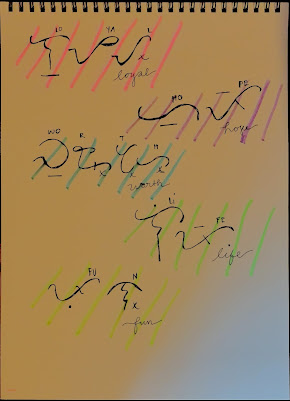Point, Line, and Plane
Baybayin "Spell"
For this project, I decided to write in Baybayin which translates to "Spell" in English. Baybayin is the native alphabet/letters that were used years ago in the Philippines. A lot of people do not know about the Baybayin alphabets including the Millenials in the Philippines. These alphabets are not used anymore or taught in schools there which is too bad considering its part of who we are as Filipinos. It truly makes me unhappy that this unique and beautiful alphabet disappeared. Even our language which is "Tagalog" is slowly vanishing since most people who live there now choose to speak in English over their own language. They even made English the official language of the Philippines. Anyhow, I thought I'd write a couple words in Baybayin for this project. In the reading, Lupton stated that using point, line, and plane forms a texture, patterns, diagrams, and so on (Lupton 32). The art I made (yes, I consider Baybayin as art) mostly shows lines and points/dots. Indeed, those two elements made patterns, texture, and shape which are the letters. Beyond that, those two elements are the reason why Baybayin has meanings. As what was said in the reading "never underestimate the power of a point" (Lupton 35), for the art I made, I would tell my audience/ readers to not underestimate the power of a line and a point.
Looking at the photograph, the line was used to form the different types of letters. It's important to know that in Baybayin, without those tiny lines and points/dots you notice in the photo those letters could not form a proper word therefore, it does not have meanings. Look at the first and second word, where are those tiny lines positioned? Well, lines in the bottom of letters signify the vowel "o" and lines in the top of the letter signify the vowel "e". Most of the letters in the Baybayin alphabet are either joined with lines or point/dot. When the letter does contain neither line nor dots it signifies the vowel "a". For instance, The first two words mean loyal and hope, without those little lines it will be read as layal and hape which does not mean anything. To signify a single letter such as "L" in the word loyal you have to put X below the letter. If the lines on the top and bottom of the letter signify the vowel "o" and "e" the point/dot signifies the vowel "i" and "u". The point on top of the letter is the vowel "i" as shown in the word life and the bottom dot is the vowel "u" as shown in the word fun. These words are chosen intentionally. I want the audience to see the importance of lines and points in this alphabet. Those two elements gave my ancestors and the native people in the Philippines the opportunity to create beautiful and meaningful words in our own language.
Ellen Lupton "Graphic Design".
Social media link: https://www.flickr.com/photos/190383081@N05/




I really like your native alphabet in Philippines. And I agree that this language should be used continually. I feel sorry for it gradually disappearing.
ReplyDeleteBaybayin writing is beautiful! I am so happy you made a post about this because you educated me and exposed me to something I didn't have knowledge of. I think it's an amazing way to connect this beautiful native alphabet from the Phillipines with this reading assignment.
ReplyDeleteThank you for sharing this! I learned sooo much. I'll have to show this to my mother to see if she was taught or has heard of the Baybayin alphabet. Your art and writing is so beautifully done!
ReplyDeleteI was so intrigued by this alphabet, I showed this to my mom and she never heard of this before even though she grew up in Manila. I find these strokes of lines so beautiful thank you for teaching me and my family something new!
ReplyDelete